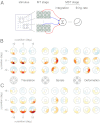Hierarchical processing of complex motion along the primate dorsal visual pathway
- PMID: 22308392
- PMCID: PMC3341052
- DOI: 10.1073/pnas.1115685109
Hierarchical processing of complex motion along the primate dorsal visual pathway
Abstract
Neurons in the medial superior temporal (MST) area of the primate visual cortex respond selectively to complex motion patterns defined by expansion, rotation, and deformation. Consequently they are often hypothesized to be involved in important behavioral functions, such as encoding the velocities of moving objects and surfaces relative to the observer. However, the computations underlying such selectivity are unknown. In this work we have developed a unique, naturalistic motion stimulus and used it to probe the complex selectivity of MST neurons. The resulting data were then used to estimate the properties of the feed-forward inputs to each neuron. This analysis yielded models that successfully accounted for much of the observed stimulus selectivity, provided that the inputs were combined via a nonlinear integration mechanism that approximates a multiplicative interaction among MST inputs. In simulations we found that this type of integration has the functional role of improving estimates of the 3D velocity of moving objects. As this computation is of general utility for detecting complex stimulus features, we suggest that it may represent a fundamental aspect of hierarchical sensory processing.
Conflict of interest statement
The authors declare no conflict of interest.
Figures







Similar articles
-
Pattern motion selectivity of spiking outputs and local field potentials in macaque visual cortex.J Neurosci. 2009 Oct 28;29(43):13702-9. doi: 10.1523/JNEUROSCI.2844-09.2009. J Neurosci. 2009. PMID: 19864582 Free PMC article.
-
Response latencies of neurons in visual areas MT and MST of monkeys with striate cortex lesions.Neuropsychologia. 2003;41(13):1738-56. doi: 10.1016/s0028-3932(03)00176-3. Neuropsychologia. 2003. PMID: 14527538
-
Attentional modulation strength in cortical area MT depends on stimulus contrast.Neuron. 2002 Jul 18;35(2):365-70. doi: 10.1016/s0896-6273(02)00778-x. Neuron. 2002. PMID: 12160753
-
A neural-based code for computing image velocity from small sets of middle temporal (MT/V5) neuron inputs.J Vis. 2012 Aug 1;12(8):1. doi: 10.1167/12.8.1. J Vis. 2012. PMID: 22854102 Review.
-
Primate extrastriate cortical area MST: a gateway between sensation and cognition.J Neurophysiol. 2021 May 1;125(5):1851-1882. doi: 10.1152/jn.00384.2020. Epub 2021 Mar 3. J Neurophysiol. 2021. PMID: 33656951 Review.
Cited by
-
Auditory and Visual Motion Processing and Integration in the Primate Cerebral Cortex.Front Neural Circuits. 2018 Oct 26;12:93. doi: 10.3389/fncir.2018.00093. eCollection 2018. Front Neural Circuits. 2018. PMID: 30416431 Free PMC article. Review.
-
Distributed encoding of curvilinear self-motion across spiral optic flow patterns.Sci Rep. 2022 Aug 4;12(1):13393. doi: 10.1038/s41598-022-16371-4. Sci Rep. 2022. PMID: 35927277 Free PMC article.
-
Processing of Egomotion-Consistent Optic Flow in the Rhesus Macaque Cortex.Cereb Cortex. 2017 Jan 1;27(1):330-343. doi: 10.1093/cercor/bhw412. Cereb Cortex. 2017. PMID: 28108489 Free PMC article.
-
Functional dissection of signal and noise in MT and LIP during decision-making.Nat Neurosci. 2017 Sep;20(9):1285-1292. doi: 10.1038/nn.4611. Epub 2017 Jul 24. Nat Neurosci. 2017. PMID: 28758998 Free PMC article.
-
Encoding of ultrasonic vocalizations in the auditory cortex.J Neurophysiol. 2013 Apr;109(7):1912-27. doi: 10.1152/jn.00483.2012. Epub 2013 Jan 16. J Neurophysiol. 2013. PMID: 23324323 Free PMC article.
References
-
- DeAngelis GC, Ohzawa I, Freeman RD. Spatiotemporal organization of simple-cell receptive fields in the cat's striate cortex. II. Linearity of temporal and spatial summation. J Neurophysiol. 1993;69:1118–1135. - PubMed
-
- Pasupathy A, Connor CE. Shape representation in area V4: Position-specific tuning for boundary conformation. J Neurophysiol. 2001;86:2505–2519. - PubMed
-
- Brincat SL, Connor CE. Underlying principles of visual shape selectivity in posterior inferotemporal cortex. Nat Neurosci. 2004;7:880–886. - PubMed
Publication types
MeSH terms
Grants and funding
LinkOut - more resources
Full Text Sources
Research Materials

